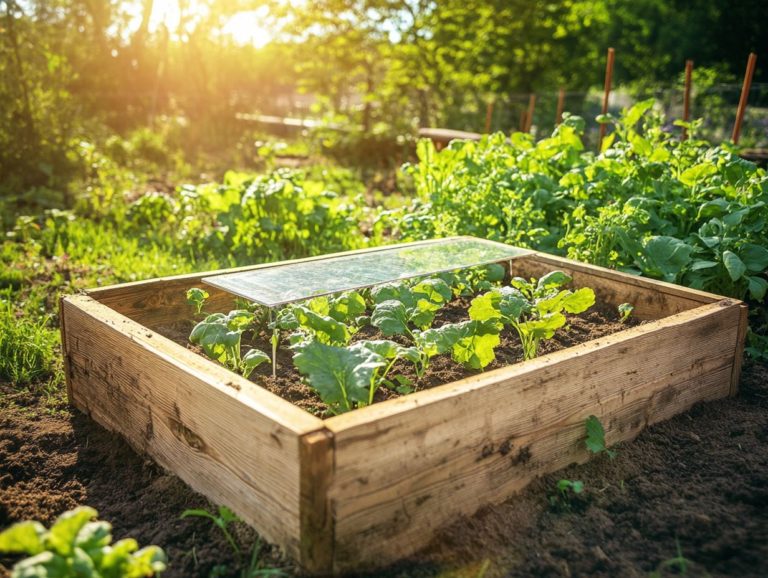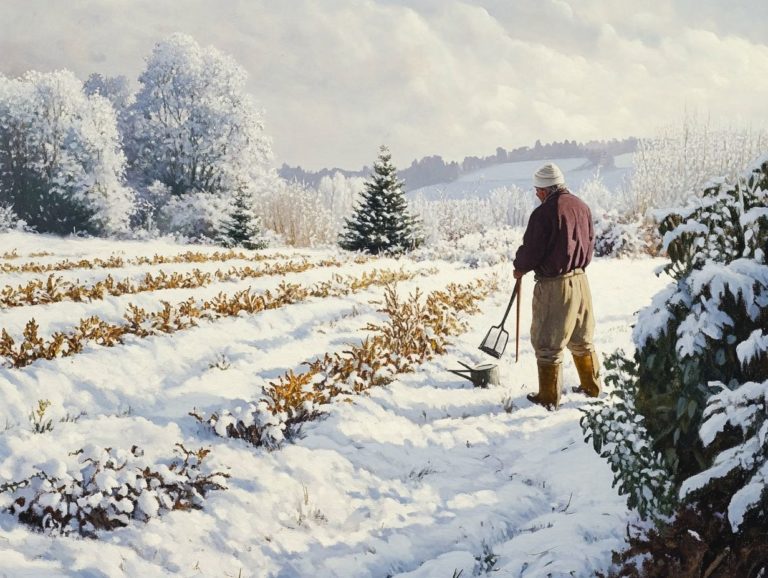How to Extend Your Harvest Season in Winter
While winter seems like a break for your garden, it’s actually a golden opportunity for smart gardeners and farmers like you.
This article explores winter harvesting and its many benefits from extending your harvest longevity to uncovering crops that thrive in the cool season.
You ll discover practical steps to prepare for winter, techniques to shield your plants, and expert tips for maximizing both yield and quality.
Get ready to transform your gardening game this winter and fully embrace the abundant possibilities the colder months can offer!
Contents
- Key Takeaways:
- Explanation of the Concept
- Benefits of Winter Harvesting
- Preparing for Winter Harvesting
- Winter Harvesting Techniques
- Recommended Crops for Winter Harvesting
- Protecting Crops in Winter
- Tips for Successful Winter Harvesting
- Frequently Asked Questions
- How can I extend my harvest season in winter?
- What are cold frames and how can they help extend my harvest season in winter?
- Can I use hoop houses to extend my harvest season in winter?
- What types of vegetables can I grow to extend my harvest season in winter?
- How can covering soil with organic material help extend my harvest season in winter?
- Is changing the types of plants I grow each season important for extending the harvest season in winter?
Key Takeaways:
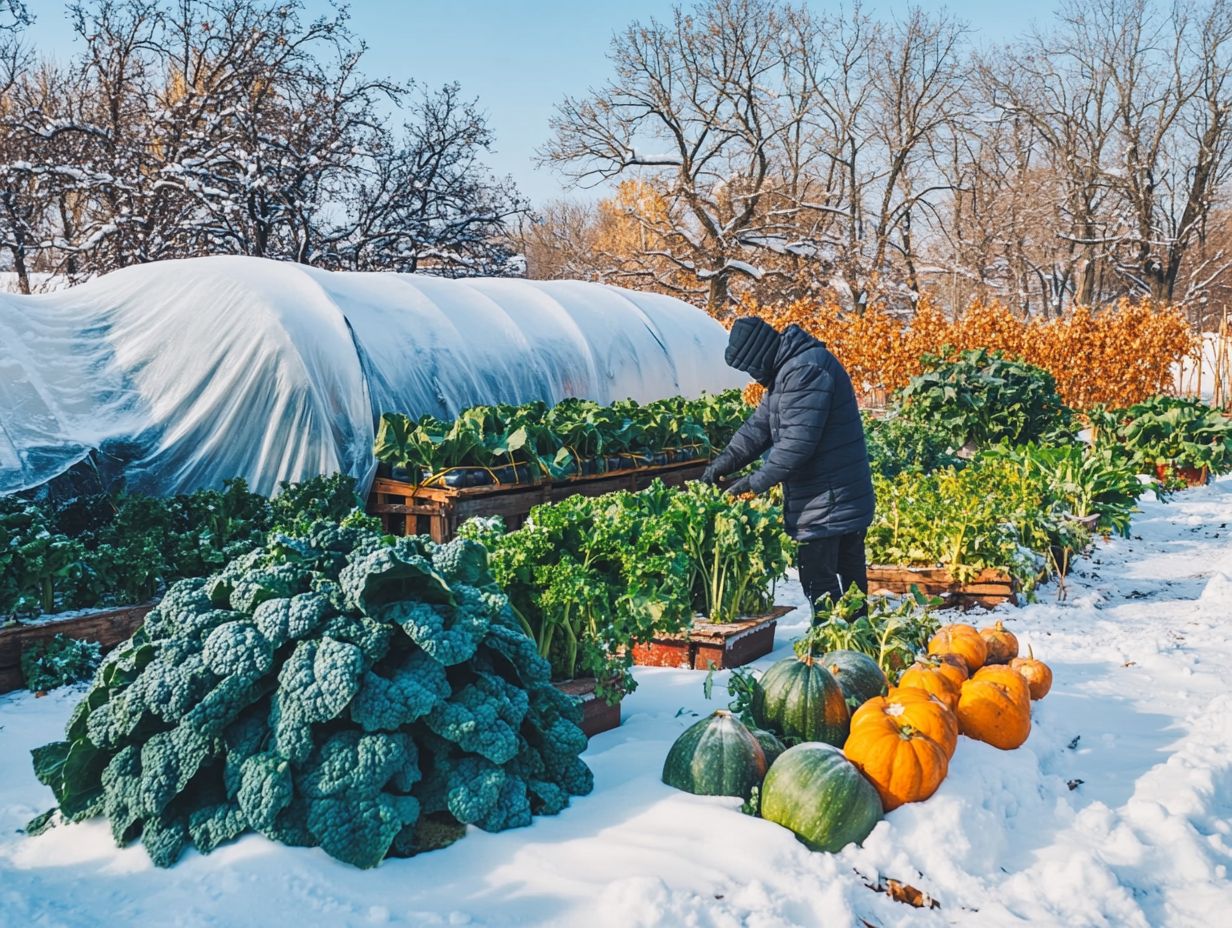
- Plan ahead for winter harvesting by selecting suitable crops, protecting plants from the cold, and using effective techniques to extend your growing season.
- Winter harvesting provides numerous advantages, such as a longer growing season, increased food supply, and potential cost savings.
- By choosing the right crops and using proper techniques, you can successfully harvest during winter and enjoy fresh produce year-round.
Explanation of the Concept
Extending the harvest is a smart strategy that involves various gardening techniques aimed at growing more food beyond the conventional growing season, especially during the cool season and late fall. Learning how to start your winter gardening early can be particularly beneficial for maximizing your yield.
By using strategies like cold frames (structures that protect plants from cold), row covers (fabric covers that shield plants), and high tunnels (temporary greenhouses), you can grow vegetables even as temperatures drop, creating a thriving winter garden full of fresh produce.
Imagine enjoying cold-hardy varieties such as kale, broccoli, and spinach, all thanks to your careful planning.
By mastering the planting schedule and timing for each crop, you can manage your vegetable care with precision, ultimately achieving crop maturity and a bountiful harvest.
Benefits of Winter Harvesting
Winter harvesting offers a wealth of benefits, allowing you to savor fresh food during the cooler months while optimizing productivity in your garden beds and raised beds.
You can safeguard your crops using effective frost protection techniques, such as insulated soil and mini hoops, to protect cold-hardy crops like carrots, leeks, and Brussels sprouts from light frost, ensuring a steady supply of winter vegetables.
This extended growing season not only enhances your food security but also promotes sustainable gardening practices that benefit both you and the environment.
Advantages for Gardeners and Farmers
The benefits of winter harvesting for gardeners and farmers are numerous. You gain increased access to fresh food, improved crop protection, and effective gardening techniques that support year-round productivity.
By choosing cold-hardy vegetable crops like garlic chives and radishes, you can maintain a harvest that meets your nutritional needs even in the chill of winter.
This approach reduces reliance on store-bought produce, which can be costly and less nutritious, while offering significant economic benefits by lowering your overall grocery bills.
For instance, community gardens that use winter harvesting techniques often report increased yields, enabling participants to share resources and minimize waste.
The simple act of growing vegetables like Brussels sprouts or kale during the winter can provide joy and satisfaction, offering a pleasant escape from winter blues while promoting a sustainable environment.
Utilizing methods like low tunnels or row covers can enhance crop protection, ensuring your winter harvest is both successful and plentiful.
Preparing for Winter Harvesting
Preparing for winter harvesting requires a thoughtful approach. Engage in a series of strategic steps during late fall to cultivate a thriving winter garden. Consider using aquaponics for winter gardening as you begin by evaluating your planting schedule and optimizing the space in your garden and raised beds.
This effective preparation is essential for ensuring that your vegetable crops are primed to endure the frosty conditions ahead. Employ techniques like soil insulation, compost mulch, and select the right varieties. These actions significantly enhance your chances of successful crop timing and maturity.
Steps to Take Before Winter
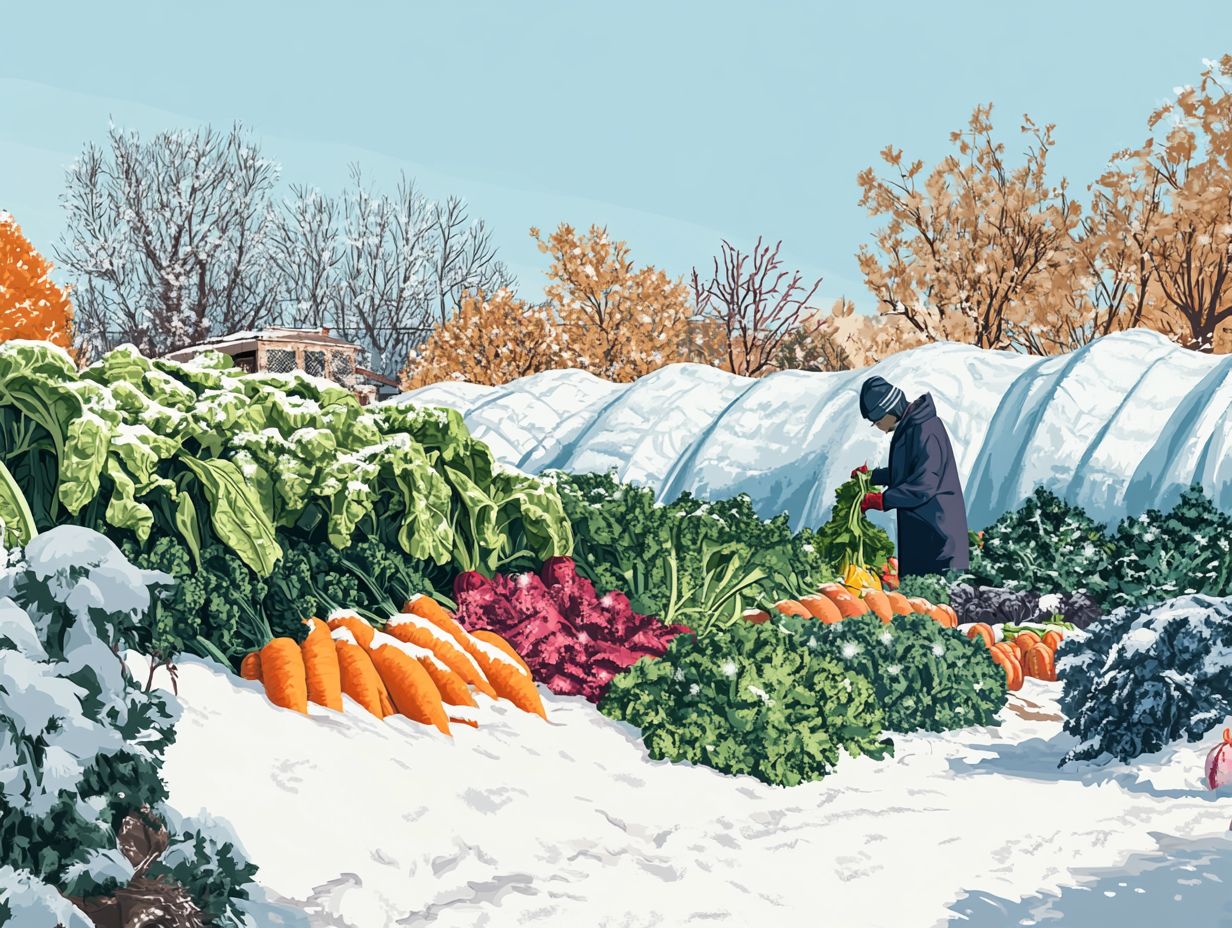
Before diving into winter harvesting, take some key steps: adjust your planting schedule and implement effective frost protection measures. You can also learn how to use a greenhouse in winter gardening to choose vegetable crops that thrive in cooler temperatures. Planning ahead and factoring in local frost dates and soil conditions will enhance your chances of a successful winter yield.
To optimize your winter gardening experience, prepare your soil carefully. Enrich it with organic matter and ensure proper drainage. Select hearty crops like kale, brussels sprouts, and winter carrots to boost your odds of a bountiful harvest.
Don t wait! Use row covers or cold frames now as effective frost protection methods. These can safeguard your plants from extreme temperature drops. Timing your planting with regional climate patterns allows for better growth before frost arrives, ultimately leading to a sustainable and fruitful winter garden.
Winter Harvesting Techniques
Use various winter harvesting techniques to effectively extend the growing season in cold climates and ensure your crops thrive, even in challenging conditions.
By using structures such as cold frames, row covers, and high tunnels, you create microclimates, or small areas with different climate conditions, that shield your plants from extreme cold. This approach maintains optimal growing conditions for cold-hardy vegetable varieties like winter squash and turnips, ensuring a bountiful harvest despite the chill.
Methods for Extending the Harvest Season
Methods for extending your harvest season include using cold frames, row covers, and mini hoop tunnels to create protective environments for your crops during winter. These tips for sustainable winter gardening shield your plants from frost while fostering optimal growth conditions in cooler temperatures. Enjoy fresh food well into the chillier months!
To effectively implement cold frames, orient them towards the sun. Fill them with fast-growing varieties like lettuce and spinach, which flourish in cooler climates. Row covers, made from lightweight fabric, protect young seedlings of kale and broccoli from harsh winds while allowing sunlight and moisture to filter through.
Meanwhile, mini hoop tunnels offer an even more controlled environment, ideal for planting crops such as carrots and radishes. By combining these methods, you can significantly extend your harvest season and ensure a continuous supply of fresh produce, even as frost looms on the horizon.
Recommended Crops for Winter Harvesting
In the realm of winter harvesting, specific vegetable varieties emerge as your top contenders for cold-season crops. These ensure both nutrient retention and a steady supply of fresh produce.
Consider incorporating cold-hardy options like kale, peas, and carrots into your garden. These resilient varieties can endure frost and deliver a reliable yield throughout the winter months. They enrich your meals with freshness, even in the coldest season.
Start planning your winter garden today for a fresh harvest!
Types of Plants that Thrive in Winter
Several types of plants flourish in winter, particularly the cold-hardy varieties and root crops that thrive under chilly conditions. Think of vegetables like garlic chives, spinach, and radishes. They not only survive the frost but often taste sweeter, making them superb choices for your winter harvest.
Winter vegetables such as kale, Brussels sprouts, and overwintering onions also offer great benefits for gardeners. Kale is remarkably resilient; it withstands heavy snowfall while continuing to grow slowly. This ensures you have fresh greens throughout the season.
Brussels sprouts taste better in colder temperatures, delivering a rich, nutty flavor that elevates your dishes. If you plant overwintering onions in late fall, you can look forward to harvesting them in early spring. This gives your growing season a delightful head start.
Together, these cold-hardy plants enhance your winter cuisine and contribute to a diverse and resilient garden ecosystem during those chilly months.
Protecting Crops in Winter

Protecting your crops in winter is essential for ensuring their survival and productivity. You can use various gardening techniques that focus on frost protection and plant management.
By implementing strategies such as using row covers, insulating the soil, and utilizing mini hoops, you significantly bolster the resilience of your vegetable varieties against the harsh challenges of winter weather.
Ways to Keep Plants Safe from the Cold
There are several effective ways to keep your plants safe from the cold. Focus on cold protection techniques that utilize season extenders and other protective measures. Insulate the soil using mulch and compost. Structures like cold frames ensure your crops are secured against low temperatures and adverse weather.
Consider using row covers made from lightweight fabric. These covers provide an extra layer of warmth while allowing sunlight to penetrate and effectively safeguard your plants against frost.
If you live in an area prone to sudden temperature drops, cloches can be a lifesaver. These handy devices can easily be placed over individual plants, creating a cozy greenhouse effect.
Keeping a close watch on weather forecasts is crucial. The timing of these protective measures can significantly impact your plants’ survival. Grouping your pots together helps them share heat and shield one another from cold winds.
Try these practical methods to give your plants a fighting chance this winter! They not only enhance your plants’ resilience but can also help you navigate seasonal changes in winter gardening, allowing you to enjoy your greenery for even longer.
Tips for Successful Winter Harvesting
Achieving a successful winter harvest demands a thoughtful blend of strategic planning and adept gardening techniques. These focus on maximizing both yield and crop quality.
By following precise planting schedules, employing effective frost protection methods, and selecting the right vegetable varieties, you can learn about overcoming winter gardening challenges to ensure a bountiful harvest during the winter months.
Embrace these practices, and you ll find your garden thriving even in the chill of winter!
Advice for Maximizing Yield and Quality
Maximizing yield and quality during winter harvesting requires specific strategies. Consider implementing tips for growing microgreens in winter along with effective gardening techniques and smart crop management to boost productivity.
Select vegetable varieties that thrive in cold weather. This choice leads to a more resilient harvest during the chillier months.
Make sure to tweak your care routines, including watering practices and fertilization schedules. Lower temperatures can slow down plant metabolism.
A thoughtful approach to covering soil with organic material not only helps regulate temperature but also preserves moisture. This strategy is invaluable for enhancing overall yield.
By remaining proactive and informed about changing conditions, you can optimize your efforts and enjoy high-quality harvests, even in the depths of winter.
Frequently Asked Questions
How can I extend my harvest season in winter?
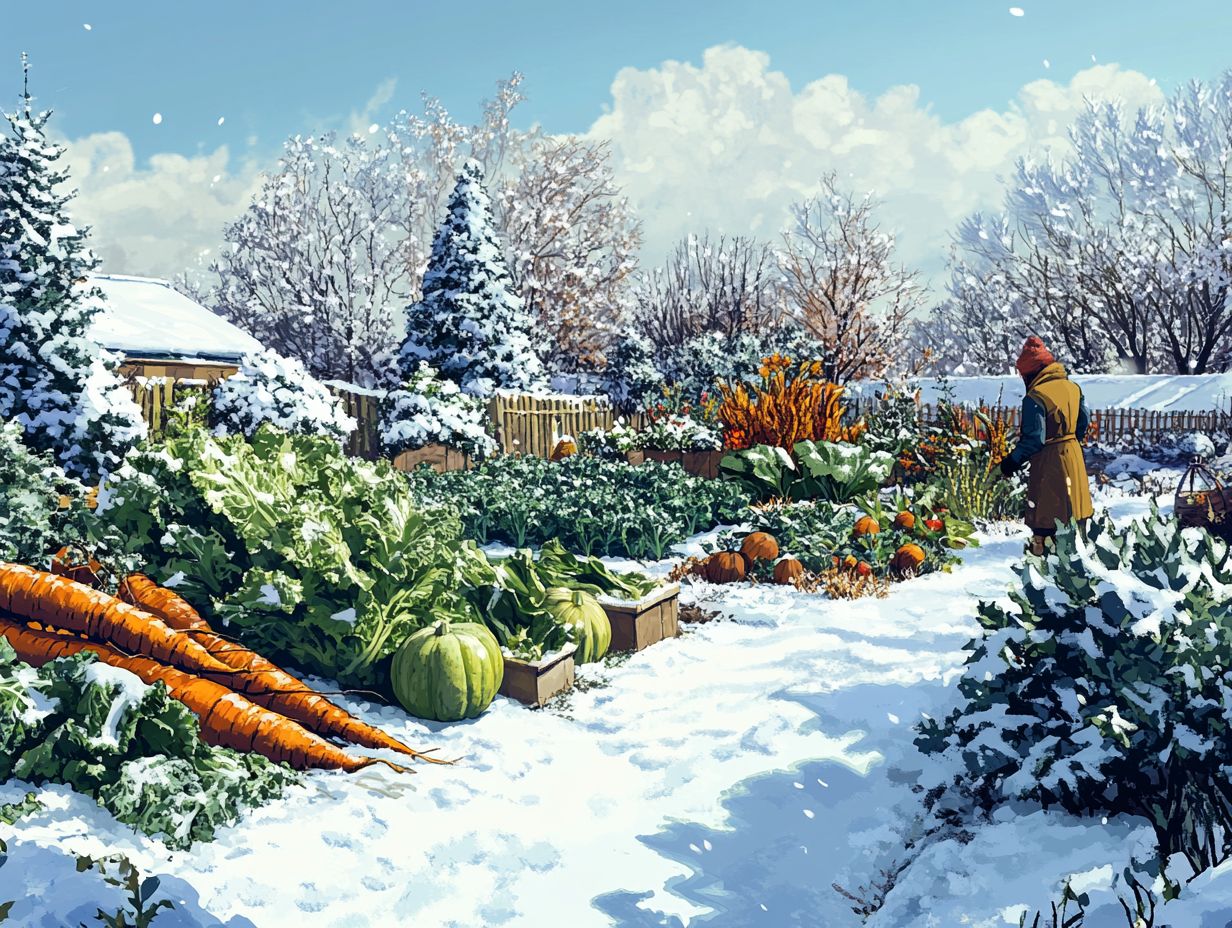
There are several ways to extend your harvest season in winter, such as using cold frames, hoop houses, and row covers. To further enhance your efforts, consider maximizing yield with top winter gardening techniques. You can also grow cold-hardy vegetables and use season extension techniques like covering soil with organic material and changing the types of plants you grow each season.
What are cold frames and how can they help extend my harvest season in winter?
Cold frames are structures built with transparent roofs and sides that capture and retain heat from the sun. They protect plants from harsh winter conditions, allowing you to grow vegetables for a longer period of time.
Can I use hoop houses to extend my harvest season in winter?
Yes, hoop houses are an effective way to extend your harvest season in winter. These structures, made from PVC pipes or metal hoops covered with plastic sheeting, provide a warm and protected environment for plants to thrive during the colder months.
What types of vegetables can I grow to extend my harvest season in winter?
Cold-hardy vegetables such as kale, spinach, Brussels sprouts, and carrots are ideal for growing in winter. These crops can withstand freezing temperatures and continue to produce, even in the colder months.
How can covering soil with organic material help extend my harvest season in winter?
This technique helps to insulate the soil and protect plants from freezing temperatures, allowing them to continue growing and producing throughout the winter season.
Is changing the types of plants I grow each season important for extending the harvest season in winter?
Yes, this practice is crucial for maintaining soil health and extending the harvest season in winter. By rotating crops, you can prevent the buildup of pests and diseases in your soil, ensuring the success of your winter crops.


